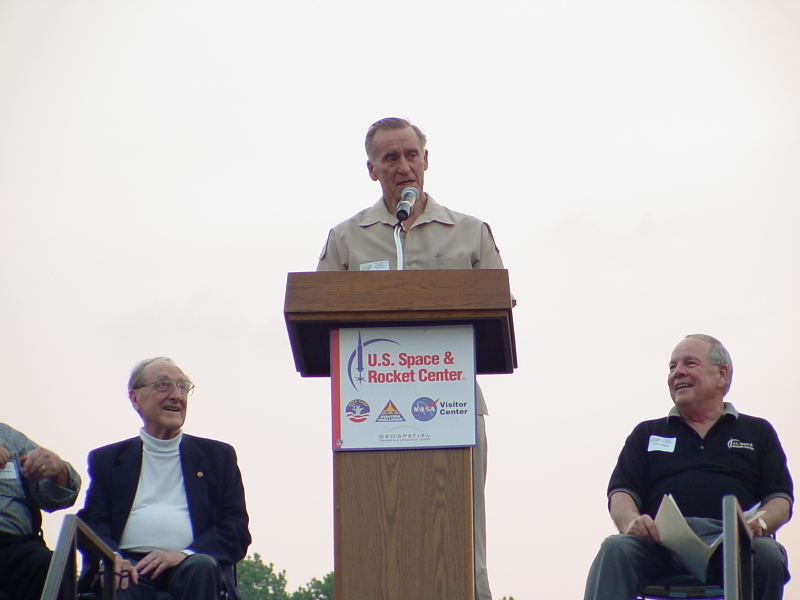| Prev |
heroicrelics.org USSRC Saturn/Apollo Reunions Site Index Third Annual Saturn/Apollo Reunion (2006) Gallery |
Next |
Walt Cunningham
Walt Cunningham was the evening's final speaker:
Larry neglected to mention that I was also a Marine Corps fighter pilot. I can't ever let Dick get ahead of me on that [laughter]. I know that there are some Marines out there.
Actually, Larry, you could have introduced the both of us as just "ancient astronauts." [Laughter.]
Dick may not remember, but it was 43 years ago this month that we met, when we were both going through the astronaut selection process.
Dick's wife, Linda, tells me that he's reminding her more and more of an old television set: the instant-on is off, his color's fading, he's taking longer to warm up, and the vertical hold isn't what it used to be. [Laughter.]
Wo sind meine deutschen Freunde? [Scattered calls of "here"] Deine Hände, bitte. Konrad, others? Vielen Dank für alle Ihren Arbeit. [Where are my German friends? Your hands, please. Many thanks for all your work.]
The Marshall Space Flight Center was the organization that first put America into space. It was the first manned flight of that Redstone rocket over there that inspired me to become an astronaut, and I won't forget the first time I ever met Wernher von Braun, right here at Marshall Space Flight Center, in March of 1964. We had two days of briefings there on just what space was all about. It was very impressive, and I suspect that some of the gentlemen here this evening were at that briefing.
And you know something? You did it right! We never lost an astronaut on any Saturn mission all the way through the Apollo and Skylab programs. Through the good graces of the Saturn V, twelve Americans walk on the moon.
And make no mistake about it: 500 years from now, there's only going to be one thing that they remember about the twentieth century -- that man first left this planet and landed on another body in the universe.
Max Faget, whom many of you out there probably know, was one of those pioneers. He had a hand in the design of every manned spacecraft that we've flown, up to and including the Shuttle. Max died a couple of years ago. A couple of years before that, to some reporter, he had this to say. He said, "Some day, they're going to want to go back to the moon and then they're going to find out just how good a job we did."
And that certainly is the truth.
And now, of course, the plan is to return to the moon. It won't be as quick as the last time, for some reason. [Chuckles.] In my opinion, it's probably even going to cost more than it did the first time. But a major role in that program is going to be the Marshall Space Flight Center once more. And that's a whole lot to have going for that program to the moon, Mars, and beyond.
Thank you.
Larry Capps' closing comments:
And to all of you out there: For those who participated in this afternoon's ground breaking ceremony, thank you for being here. And for those of us joining us this evening, to celebrate one of man's greatest achievements, going to the moon, thank you for being here.
For those of you who participated in the Saturn V program, I invite you to join your Saturn/Apollo colleagues for a very special photo.
We ask those of you in the audience to remain seated while the rocket team, that's everyone who worked or flew during the Apollo program, now moves to the museum atrium. We will have guides posted to show you the way, and they will help you set up for this picture.
Again, thanks to all of you for being here this evening. Thank you for your support. And thank you for helping us preserve the Saturn V.
Good night.

| Time picture taken | Sat Jul 15 19:35:47 2006 |
| File name | dsc18700.jpg |
| Location picture taken | Rocket Park US Space & Rocket Center Huntsville, AL |
| Prev | Third Annual Saturn/Apollo Reunion (2006) Gallery | Next |